#Maria Habsburg
Explore tagged Tumblr posts
Text
SIX THE MUSICAL - MODERN!AU: illustration




Anna's family tree
#Johann la Mark-Kleve III#Maria von Jülich-Berg#Sybille von der Kleve-Berg#Anna von der Kleve-Berg#Wilhelm von der Kleve-Berg#Amalia von der Kleve-Berg#Johann Friedrich von Sachsen#Johann Friedrich von der Kleve-Sachsen Junior#Johann Wilhelm von der Kleve-Sachsen#Johann Ernst von der Kleve-Sachsen#Jane Lilian Seymour#Maria Habsburg#Jean d'Albret#Marie Eleonor van der Kleve-d'albret-Habsburg#Karl Friedrich von der Kleve-d'Albret-Habsburg#Anna Magdalen von der Kleve-d'albret-Habsburg#six#six the musical#anna of cleves#anna von kleve#jane seymour#anne of cleves#modern!au#six modern!au#six the musical modern!au#six the musical illustration#six illustration#illustration#family tree#clevemour
14 notes
·
View notes
Text






In any case it seems that Maria Theresa had expected a daughter. One of her courtiers, Count Dietrichstein, wagered against her that the new baby would be a boy. When the appearance of a girl, said to be as like her mother as two drops of water, meant that he had lost the bet, the Count has a small porcelain figure made of himself, on his knees, proffering verses by Metastasio to Maria Theresa. He may have lost his wager but if the new-born augusta figlia resembled her mother, then all the world would have gained.
Marie Antoinette: The Journey - Antonia Fraser
#marie antoinette#maria theresa#18th century#house of habsburg#austria#house of habsburg lorraine#long live the queue#pretend that's little antoine there ok :P
81 notes
·
View notes
Text
The Birth of Charles II of Spain Fanart

Warning: This story contains some artistic license
The Queen's pregnancy was approaching its end and had become a matter of utmost importance. The future of the Monarchy depended on this event. On Sunday, November 6, everything seemed to be ready. The doctors and physicians were on alert; the Queen's confessor was near her, and the Chief Steward of her Household was carefully reviewing the arrangement of the items in the birth chamber. To guarantee the success of the event, all the holy relics that were in the Palace and others brought from El Escorial and other places had been arranged in order. There was the staff of Saint Dominic of Silos that the Order of Saint Dominic had brought, the ribbon of Saint John Ortega, from the Order of the Hieronymites; the incorrupt bodies of Saint Isidore and Saint Diego de Alcalá; the image of the Virgin of Solitude and the one so venerated by the royal family, Our Lady of Atocha. It is not easy to find a space so holy and sacred. Everything, then, was ready, the things of the earth arranged to implore God's pleasure. At noon, after a frugal lunch, Philip IV retired to his chambers. At the same time, While eating, Queen Mariana suddenly felt intense pain in her abdomen, realizing that she was about to give birth. She quickly left the table and hurried to the Tower Chamber.
King Philip went straight to his study while looking at Prospero’s portraits. He entered his study, sat down, and began to write to answer the last letter of Sor Maria de Agreda. He wrote with a deep sigh and tears in his eyes.
“ With the long illness of my son, and the continuous help I was giving in his room, I have not answered your letter of the last month...I assure you that what has most exhausted me, more than this loss, is to see clearly that I have vexed God and he sent this punishment to castigate my sins...
(The king reminisces his cherished memories with Felipe Prospero while writing this letter)
Help me as a friend with your prayers to placate God’s just anger and beg Our Lord that, as he took my son from me, He may make his light shine on the Queen, whose confinement we await hourly, and give her good health and guard what is to be born, if his will, for otherwise I do not wish it...
Back in the Tower Chamber, Queen Mariana cries in agony as she is delivering her baby. The royal midwife Ines Ayala told Queen Mariana to push harder. Five other doctors were present at this event in case of emergency. One of those doctors was Dr Bravo. While the Queen was giving birth, the courtiers and Infanta Margarita looked on.
Ah, Sor Maria, If I had succeeded in following your teachings, perhaps I would not have found myself thus. Pray to our Lord that he may open his eyes, that I may perform his holy will in all things... There is nothing new in the English situation. I, thank God am in good health...
At this point, King Philip was interrupted by a courtier who delivered the news and told the events occurring in the Tower Chamber. King Philip was anxious about the future that lay within a few hours. He prayed heavily to God, asking him to deliver him a son. All could imagine the impatience of the Royal Court of Madrid and Europe, waiting for an outcome of this event. As hours passed, Queen Mariana was still in labor, and the doctors argued over natural forms of treatment. They were anxious as the Queen and the child’s life was at stake.
Dr. Bravo proposed a theory: In the past, Queen Mariana had difficult experiences giving birth to her children. At the birth of Maria Ambrosia, Felipe Prospero, and Fernando Tomas, The Queen had terrible epileptic seizures, and the infants died or lived for a short time. On the other hand, at the birth of Infanta Margarita, the only child to survive, The Queen had been perfectly well. Now why was this? The reason is simple: Just before Infanta Margarita was born, Queen Mariana had suffered several violent nosebleeds. Therefore, what she requires now is to be bled.
Some doctors disagreed, warning that the proposed action could endanger the Queen and her child. Concerned, Queen Mariana asked the doctors if there were any alternative procedures. The doctors offered different opinions, while Dr. Bravo defended his proposal. As the debate continued, Mariana went into labor with the assistance of Ines Ayala. The infant cries and is alive. The birth of the infant brought joy to all. King Philip became a father once again. When the courtier informed King Philip of the birth, he was overjoyed and immediately visited the tower chamber to see his newborn son. King Philip joyfully held his son and proudly showed him to the Queen and his daughter. When the courtier informed King Philip of the birth, he was delighted and immediately visited the tower chamber to see his newborn son. King Philip joyfully held his newborn son and showed him to the Queen and his daughter.
Sources:
Carlos, A king who would not die by John Langdon Davis
Happy Birthday, Charles II of Spain!
#all I did is just combine these stories together#history#mariana de austria#spain#art#charles ii of spain#house of habsburg#17th century#habsburg#carlos ii#please like and reblog#my art#Mariana's art#happy late birthday#sorry it took me so long#my cute baby#margarita#margarita maria#philip iv#look at them#i love them so much#they are so cute#espana#kingdom of spain#madrid spain#monarquía española#spanish empire#baroque fashion#baroque#artists on tumblr
59 notes
·
View notes
Text
Folks I just came across the most incredible Habsburg lithography I've ever seen:

It doesn't look that odd at first glance but the more you look at each person the more ????? the picture becomes.
Like first I saw Emperor Franz holding hands with Empress Caroline, ok that's kind of cute! But then I noticed the then Crown Princess Maria Anna crying and praying?? What's going on.

And then I realized Crown Prince Ferdinand is fucking dying in the background???

I don't know who these guys are meant to be but the ones at the right are looking straight at the camera like if they were in The Office.


But this isn't the most ??? things of this picture. Because then I noticed the angel apparently ready to guide Ferdinad to the other world and I need you to tell me if I'm insane or if you see it too.
Guys. Guys. Is the half naked angel... Reichstadt????????

Or is it just a random twink angel???????? Please tell me what you think this will drive me insane jgkgk.
EDIT because I noticed the angel has a dagger so maybe he's actually protecting Ferdinand from death (and if he is meant to be Franz then it's sweet that he's depicted as an angel who protects his family from the other side not that they deserve it much lol)
Anyway I looked it up and apparently Ferdinand almost died in December of 1832, so this lithography of 1833 is depicting that, in a very normal, not bizarre at all way.
#i can't believe i went on with my life without ever seeing this before#house of habsburg#franz i of austria#empress caroline of austria#empress maria anna of austria#ferdinand i of austria#napoleon ii duke of reichstadt#maybe????? or maybe not???? do you see it or am i Crazy
59 notes
·
View notes
Text

#maria josepha of austria#house of habsburg lorraine#austrian history#art#digital illustration#taniata's art#austrian fashion#archduchess maria josepha of austria#inspired by portrait by anton raphael mengs#was intended that what was happening at work was preparation for painting a portrait#im so sorry her life was so short
42 notes
·
View notes
Text

Maria Theresa doodles ;_D
#digital art#sketch#doodle#historical art#habsburg history#house of habsburg#habsburg#maria theresa#spanish monarchy#infanta maria theresa#artists on tumblr#digital sketch#17th century#1600s#herr
31 notes
·
View notes
Text
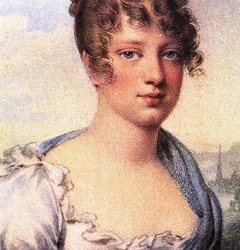

Maria Leopoldina, Empress of Brazil, reigned from 1822-1826
This Barbie made Brazil independent
Napoleon II, Duke of Reichstadt
Died young but loved in this bracket
Please go read @archduchessofnowhere's post about their relationship here. It is very sweet.
#best habsburg bracket#house of habsburg#maria leopoldina#I'm working with a grand total of three portraits for each of these two#so you're getting them on repeat
106 notes
·
View notes
Text

13 Holy Roman Emperors! 5 Kings of Spain! 4 Emperors of Austria! Like the same 3 nasty chromosomes being inbred around! 1 Holy Roman Empress! The Habsburg dynasty from 1500-1918, from Charles to Charles!
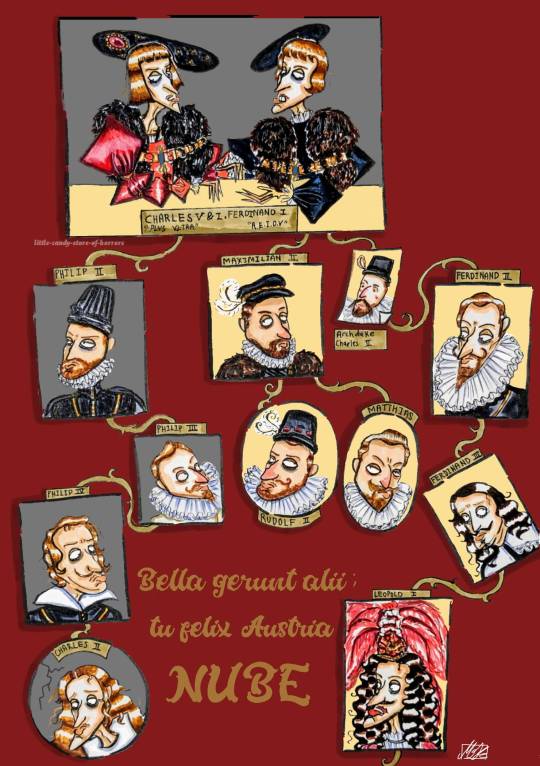
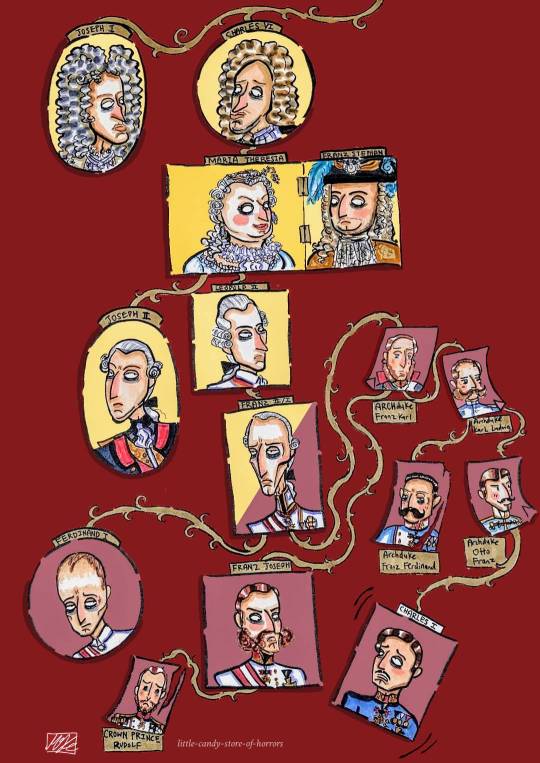
#Ok to reblog!#House of Habsburg#historical art#history art#historical portrait#austrian history#spanish history#Charles v#philip ii#philip iv#carlos ii#maria theresa#Francis ii#franz joseph#Archduke franz ferdinand#crown prince rudolf#16th century#17th century#18th century#19th century#Remember when i said might continue the family wreath to bLeSsEd Karl. Well unfortunately here we are.#Tagging only the most popular folks sorry 😔 tumblr wont let me etc#Something something it starts w the original flag n goes into black for spanish branch gold for HRE n red for austrian empire
18 notes
·
View notes
Text

“[…] beautiful Alexandra, always serious and sad…”
- Princess Maria Amalia of Naples and Sicily on Grand Duchess Alexandra Pavlovna of Russia, Archduchess of Austria.
#grand duchess alexandra pavlovna#princess maria amalia of naples and sicily#romanov#habsburg#russia#austria#portrait#quotes
78 notes
·
View notes
Text

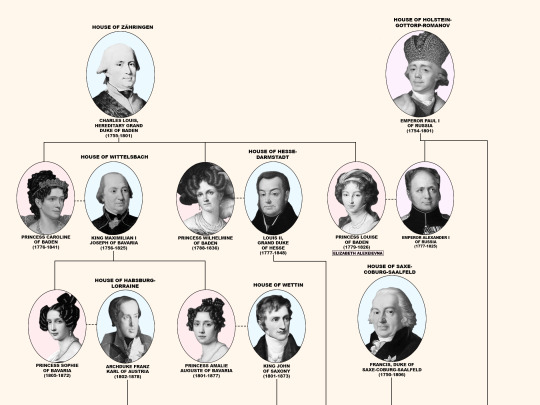
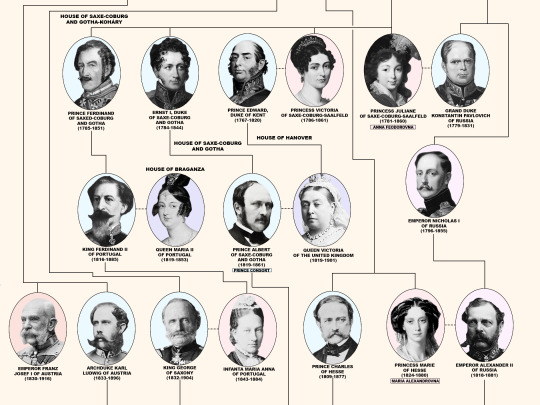

How the last Russian Dynasty were related to European Monarchies (current and former):
The House of Habsburg (Royal Dynasty of Austria) and the House of Holstein-Gottorp-Romanov (Imperial Dynasty of Russia) were distantly related, their common ancestor being Charles Louis, Hereditary Grand Duke of Baden & Francis, Duke of Saxe-Coburg-Saalfeld.
#nicholas ii#alexandra feodorovna#olga nikolaevna#tatiana nikolaevna#maria nikolaevna#anastasia nikolaevna#alexei nikolaevich#romanovs#habsburg#otto von habsburg#charles I of austria#european monarchies
72 notes
·
View notes
Text
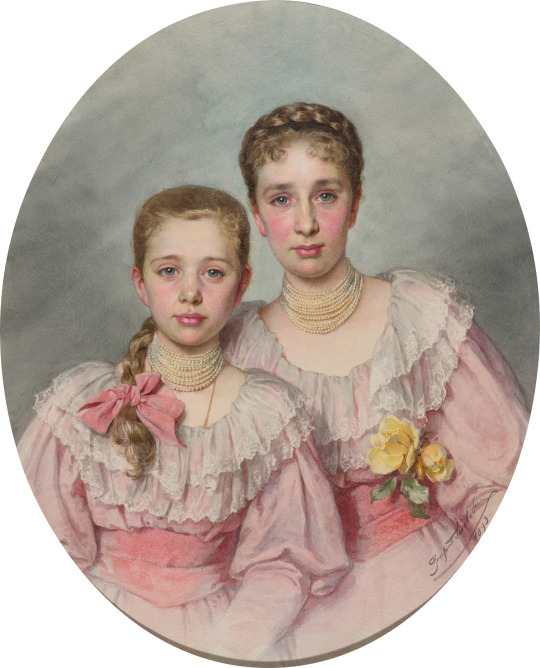
Archduchesses Maria Annunziata (1876-1961) and Elisabeth Amalie of Austria (1878-1960). By Josefine Swoboda.
They were the daughters of Archduke Karl Ludwig of Austria, brother of Emperor Franz Joseph. Maria Annunziata was Abbess of the Theresia Convent in the Hradschin, Prague; and Elisabeth Amalie Princess of Liechtenstein through her marriage to Prince Alois of Liechtenstein.
#josefine swoboda#liechtenstein museum#haus liechtenstein#german aristocracy#maria annunziata of austria#elisabeth amalie of austria#princess of liechtenstein#fürstentum liechtenstein#erzherzogtum österreich#haus habsburg lothringen#house of habsburg lorraine#erzherzogin#Theresian Institution of Noble Ladies#Tereziánský ústav šlechtičen
23 notes
·
View notes
Text

Archduke Franz Ferdinand Carl Ludwig Joseph Maria of Austria
Austrian vintage postcard
#austria#tarjeta#postkaart#sepia#ferdinand#archduke franz ferdinand carl ludwig joseph maria#carl#carte postale#ansichtskarte#maria#ludwig#briefkaart#photo#photography#postal#postkarte#vintage#archduke#joseph#franz#austrian#postcard#historic#habsburg#ephemera
4 notes
·
View notes
Text

Miniature of Archduchesses Maria Josepha and Maria Johanna Gabriela of Austria, with a jewelry box.
#maria josepha of austria#Maria Johanna Gabriela of Austria#archduchess#austria#house of habsburg lorraine#18th century#long live the queue
59 notes
·
View notes
Text

Mariana of Austria and Margarita Theresa Fanart
Be warned as some events I wrote had some artistic license.
On the morning of September 17, 1665, the bells tolled throughout the city. Jose Everardo Nithard immediately went to the Queen's chambers. Upon hearing the bells, Queen Mariana awoke and asked what was happening. The courtiers present kissed her hand. Nithard approached her and informed her that the king had passed away. The Queen began to shed a tear but kept her composure. She began to change her wardrobe from extravagant to a simple, rigid mourning dress, with the only adornment on her finger being her wedding ring. Surgeons and attendants were cleaning and embalming the king’s body while a mass was recited at the head of the royal bed. Margarita Theresa, dressed in mourning attire, approached Mariana, hugged her, and wept excessively. Mariana began to cry as she comforted her daughter.
Source: Queen, Mother, and Stateswoman Mariana of Austria and the Government of Spain by: Silvia Z. Mitchell
#I forgot that Felipe's death anniversary was last month#sorry#history#my art#my fanart#historical figures#historical fanart#baroque period#mariana de austria#house of habsburg#habsburg#carlos ii#art#17th century#please like and reblog#spain#mother and child#princess#underrated queen#mourning outfit#tw death#look at them#i love them#they are so cute#ahhhhhh#They are in mourning#so sad </3#margarita maria
59 notes
·
View notes
Note
What the tea on Maria Carolina? You said in one of your posts: “Maria Carolina truthers know she's the most interesting daughter and the one there should be hundreds of books and movies about, but the general audiences haven't seen the light yet.” I’m intrigued
Hi! Sorry it took me so long; I was reading a book about the Bourbons in Naples and I wanted to finish it to be able to give a more complete answer… but it ended up taking me MONTHS to be done with it.
This answer was a bit difficult to put together because Maria Carolina’s life was very eventful, so I’ll just mention some facts about her life, focusing more on the Napoleonic era and Napoleon specifically because I think you’ll be more interested in that. Also please feel free to correct me If I got something wrong, since this is a time period I’ve only started to learn about recently. So what was the tea?

Born in 1752 Maria Carolina was the thirteenth child of Empress Maria Theresia and Franz I, Holy Roman Emperor. As part of her mother’s policies of rapprochement to the Bourbons, she and her siblings were engaged to different members of the houses of Spain, France, Parma and Naples. Maria Carolina was promised to the Dauphin of France, but when her elder sister, promised to the King of Naples, died of smallpox, she took her place.
Ferdinando of Naples had been a child king, and he remained so for the rest of his life. His only diversions were hunting and pulling pranks on his courtiers, and he had a terrible reputation across the courts of Europe as an uneducated, bad mannered, spoiled man, kept in ignorance by his Ministers so they could control him. Everyone pitied the young Archduchess’ fate, her mother Maria Theresia wrote around the time of Maria Carolina’s wedding that she “trembled in fear for her”. But duty came first, and so she went to Naples, aged only sixteen.
Maria Carolina did not had it easy at first. She was terribly homesick and found herself in a court that could not have been more different to the one she grew up in. When her sister Maria Antonia married the Dauphin of France, she wrote to her former aya:
When I imagine that her fate will perhaps be the same as mine, I want to write volumes to her on the subject, and I very much hope that she has someone like me [to advise her] at the beginning. If not, to be frank, she may succumb to despair. One suffers real martyrdom, which is all the greater because one must pretend outwardly to be happy. I know what it is like, and I pity those who have yet to face it… I would rather die than endure again what I went through at the beginning. Now all is well, which is why I can say—and this is no exaggeration—that if my faith had not told me, ‘Set your mind on God,’ I would have killed myself.
Unsurprisingly Maria Carolina didn’t fall head over heels for her husband, but she did convince him that she had, and eventually won his affection. After she bore a son in 1775 she earned a seat in the State Council (as her marriage contract established), and from that point onward she became an active player in Neapolitan politics. One of her firsts moves was to remove the Secretary of State, Marchese Tanucci, who had been Regent during her husband’s minority and still held a huge influence over him.
After Tanucci’s dismissal she became the person with the most influence over Ferdinando, and she pretty much had him wrapped around her finger for most of their marriage, acting as the de facto ruler of Naples. Every decision the king took was only after consulting his wife, and she often had the final say. However, this didn’t meant Maria Carolina held absolute power: Ferdinando was still a very unpredictable person, and as soon as his wife was out of his favor he stopped listening to her.
Maria Carolina was enthusiastic about the ideas of the Enlightenment, as many other royals were at first, and even protected and encouraged the Masons in Naples during her early years as queen. But she was still the consort of an absolute monarch that believed they were chosen by God to rule, so it shouldn’t come as a surprise that she was horrified by the French Revolution and fervently opposed it. If it were for her, she would've declared war on France immediately, but this was not possible. On the execution of her brother-in-law Louis XVI she wrote:
Knowing your upright mind, I can imagine your emotion on hearing of the appalling crime perpetrated against the unfortunate King of France in all solemnity, tranquillity and illegality (…) He was the head of our family, our kinsman, cousin and brother-in-law. What an atrocious example! What an execrable nation! I know nothing about the other wretched victims in the Temple. If sorrow does not kill them, other horrors may be expected from this horde of assassins. I hope that the ashes of this good Prince, of this too good Prince who has suffered shame and infamy for four years culminating in execution, will implore a striking and visible vengeance from divine Justice, and that on this account the Powers of Europe will have no more than a single united will, since it is a matter in which they are all involved.
She was growing increasingly anxious about her sister, Queen Marie Antoinette, and her hatred for France became an obsession:
I hear horrible details from that infernal Paris. At every moment, at every noise and cry, every time they enter her room, my unfortunate sister kneels, prays and prepares for death. The inhuman brutes that surround her amuse themselves in this manner: day and night they bellow on purpose to terrorize her and make her fear death a thousand times. Death is what one may wish for the poor soul, and it is what I pray God to send her that she may cease to suffer. . . . I should like this infamous nation to be cut to pieces, annihilated, dishonoured, reduced to nothing for at least fifty years. I hope that divine chastisement will fall visibly on France, destroyed by the glorious arms of Austria.
At this point she had lost all hopes of her being rescued, and wished her “a natural death as the best thing that could happen to her”. But even though she had been waiting for it, the news of Marie Antoinette’s execution still shocked her. She wept and prayed with her children for “her wretched sister”.
Naples fell into a social crisis during these years, paranoia, fear and suspicion of the revolution in every corner. There was an active persecution of everyone thought to be a “jacobin”, arrests, trials and executions. But the country couldn’t wage war against France, and eventually they had to sign a peace treaty, which the Queen disapproved: “I am not and never shall be on good terms with the French… I shall always regard them as the murderers of my sister and the royal family”.
It was also during this time that the star of a certain Bonaparte started to rise, and Maria Carolina followed his career with interest and admiration. Before the treaty of Campo Fornio in October 17, 1797, she wrote about Napoleon:
I admire him, and my sole regret is that he serves so detestable cause. I should like the fall of the Republic, but the preservation of Bonaparte. For he is really a great man; and when one can only see ministries and sovereigns with petty and narrow views, one is all the more pleased and astonished to watch such a man rise and increase in power, while deploring that his grandeur is attached to so infernal a cause. This may seem strange to you. But while I loathe his operations, I admire the man. I hope that his plans will miscarry and his enterprises fail; at the same time I wish for his personal happiness and glory so long as it is not at our expense… If he dies they should reduce him to powder and give a dose of it to each ruling sovereign, and two to each of their ministers, then things would go better.
Soon she would have less nicer things to say about Naps, but she never lost that original admiration and astonishment.
In 1798 Ferdinando, encouraged by his wife and the British, led a expedition in December to try to expel the French from Rome. Not only the Neapolitan troops weren’t prepared to defeat the French Army, they were also technically still at peace with France, so this wasn’t a good move at all, and only two days after entering Rome Ferdinando had to retreat. Expectedly, Napoleon’s reaction to such a break of peace was marching over Naples. The royal family had to flee to Sicily, a tragic journey in which Maria Carolina’s six-years-old son Alberto died after a series of convulsions.
This ask is already too long to unpack all the political mess around the short-lived Parthenopean Republic, so to summ it up: it didn’t work out, and by 1799 the Bourbons were back in power. They were unforgiving of the republicans: during the following months there were thousands of arrest and hundreds of executions and deportations. Maria Carolina felt no mercy for them: “Death for the ringleaders, deportation for the rest... Our country must be purged of this infection”.
The Queen returned to Naples in August 1802, after more than three years of absence. She had never been a liked queen, but her unpopularity reached a new low since she was blamed for all the misfortunes of the last years. Having lost the influence she had on her husband, who held her responsible for the Rome expedition fiasco, she meddled a little less in politics now, dedicating mainly to her children and grandchildren, particularly to her unmarried daughters.
Speaking of her children, she had seventeen (!!!) but she would outlive fourteen of them. Part of her masterplan for them was to marry them all to her Habsburg nephews and nieces, and in many cases she succeeded. Just to name one exemple her eldest daughter Maria Theresa married Emperor Franz II/I of Austria. Maria Carolina’s relationship with this son-in-law ended up being a bit tense, since Franz found her mostly meddlesome and never aligned with her plans. On top of that, she was quite hurt when Franz remarried only months after her daughter’s death; after he announced his engagement she stopped adressing him as her son and resorted only to “Your Majesty” instead.
In 1804 Napoleon became Emperor, and we have a letter she wrote to Minister Gallo on this. Buckle up because whatever you imagine her reaction was, you aren’t ready for it:
It was not worth the trouble to condemn and slaughter the best of kings [Louis XVI], dishonour and revile a woman, a daughter of Maria Theresa, a holy princess [Marie Antoinette], to wallow in massacres, shootings, drownings, and kill six hundred prelates in a church, perpetrating horrors of the most barbarous ages at home and abroad, writing whole libraries on liberty, happiness, etc., and at the end of fourteen years become the abject slaves of a little Corsican whom an incredible fortune enabled to exploit all means to succeed, marrying without honour or decency the cast-off strumpet of whom the murderer Barras was surfeited, Turkish or Mohammedan in Egypt, atheist at the start, dragging the Pope after him and letting him die in prison, a devout Catholic after that, practising every deceit, shortening the lives and normal careers of sovereigns who might assert themselves, only allowing the dummies to vegetate, then atrociously, without a shadow of justice, assassinating the Duc d'Enghien, plotting himself (and he did not blush to admit it, so blinded is he by passion) a conspiracy to victimize the rulers he still feared, and on top of all these abominations he is acclaimed as Emperor: he and his race of Corsican bastards are to dominate almost half Europe, yet every thinking person is not revolted. Far from it, their egoism and weakness are such that they study how low they can prostrate themselves before the new idol… Send me word of the august Emperor’s intentions regarding Italy: whether he will deign to accept us as his slaves or will leave us in our obscurity… Tell me what the other Powers are saying. I imagine a Gloria in Excelsis Demonio will be the general refrain…
She took it pretty well right?
The future of the Bourbons of Naples once again seemed bleak, and this time Maria Carolina resorted to directly appealing to Napoleon. This was the beginning of a very passive-agressive epistolary relationship, both of them trying to be civil but still borderline insulting each other. I honestly find this funny, because you have Maria Carolina swearing to Napoleon that she had nothing against him or France and then she would write this to one of her ministers: “You will never imagine the rage and despair which the extremely insolent screed of the scoundrelly but too lucky Corsican has caused me.”
Despite the passive-agressiveness, when Napoleon was looking for a princess bride for his stepson Eugène he actually considered one of Maria Carolina’s daughters, Maria Amelia, as a possible candidate. But when the Minister of Foreign Affairs Gallo told Maria Carolina of Napoleon’s inquiries about her daughter she was so utterly horrified at the idea of marrying into the Corsican’s family that the project was immediately dropped (eventually Maria Amelia would go on to marry the Duke of Orléans, later King Louis Philippe I, and became the last queen of the French).
After Austerlitz Napoleon pretty much had all of Europe eating from his hand, and the Neapolitan sovereigns felt abandoned by every other power. Maria Carolina tried one last futil attempt to plead to Napoleon, but he had already decided to take Naples. The King was the first to Sicily flee this time, the Queen stayed behind and tried to organize a resistance, but eventually she realized there was nothing they could and also fled with her daughters. Before sailing she wrote to her daughter Empress Maria Theresa of Austria: “I fear we shall never see Naples again”. She was right.
The royal couple spent their second exile the same way they spent their first: Ferdinando living his best life enjoying the freedom he had in Sicily and Maria Carolina being utterly miserable. Her health worsened and she often was in pain, but recovering Naples from the Bonapartes became her obsession. She was the leading force behind every attempt to get the kingdom back, but soon she started to crash with their only allies left, the British. They wanted to keep the Bourbons in Sicily, getting back Naples was not a priority for them.
So remember Maria Carolina’s her reaction when Napoleon suggested to marry her daughter to Eugène? Well she didn’t took her granddaughter’s marriage to Napoleon himself any better: “Only this calamity was held in reserve. To become the Devil’s grandmother”.
But at the end, the final boss in Maria Carolina’s life wasn’t Napoleon, but the British. The Queen was too meddlesome and hindered their plans, and made a personal enemy of the British representative Lord Bentinck. Maria Carolina was accused of conspiring and being a threat to Sicily, and eventually the King was forced by the British to send her away. Exiled in exile, having nowhere else to go, she returned to Vienna in an eight-months-journey. While her son-in-law had no desire to receive her, he couldn’t turned her away either. She got in a better mood once she was once back at her childhood home, spending time with her Austrian grandchildren. It was there that she heard of the French defeats and Napoleon’s abdication.
Even though Maria Carolina made her hatred of Napoleon her personality for fifteen years she felt sympathetic towards him after he was defeated, reproached Marie Louise for not going to Elba with her husband, and told her that if she wasn’t allowed to reunite with him she should tie her bed-sheets to her window and escape, because marriage was for life. She also showed a lot of interest in her great-grandson, little Napoleon II, whom she called “mon petit monsieur”; in a letter to Marie Louise she described him as “very charming, quiet and well behaved” and told her that “may God give you in him every consolation a mother can receive.”
Maria Carolina was not to see the Bourbons restored in Naples. She died of a stroke in September 8, 1814, aged sixty-two-years old. At the time of her death Murat was still King of Naples, and the allies were happy to leave Ferdinando in Sicily. She was buried in the Capuchin Crypt, her death being only a small incident in the Congress of Vienna’s dance.
Overall, I personally find Maria Carolina the most fascinating because of everything she represented: she was a healthy daughter of the ancien régime that saw how the world as she knew it crumbled down and changed forever, to the point that by the time of her death she, the last surviving child of Maria Theresia, was a living relique (and she wasn’t even that old - a testament of how fast everything had changed). And she didn't got there sitting by idly: she fought against this new world every step of the way, made it out alive, but lost the battle still. And I don't know about you, but to me this is just a more interesting story to tell than Unoriginal Marie Antoinette Adaptation Number 7383.
Sources:
Acton, Harold (1998). The Bourbons of Naples (1734-1825)
Castelot, André (1974). King of Rome; a biography of Napoleon's tragic son
Stollberg-Rilinger, Barbara (2020). Maria Theresa: The Habsburg Empress in her Time
#sorry if this answer is too long and messy - i been putting it together little by little for the past month#but this is only the top of the iceberg i left out so many things#queen maria carolina of naples#ferdinando i of the two sicilies#house of habsburg#house of bourbon-two sicilies#napoleon i#cw suicide mention#asks
55 notes
·
View notes
Text

#maria theresa of spain#art#digital illustration#taniata's art#it was interesting to draw her hair#im very pleased with this art#i like her appearance in portraits so much 🙏#she came out a lighter blonde than she should have been..#spain history#french history#house of habsburg#women in history
39 notes
·
View notes